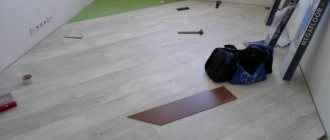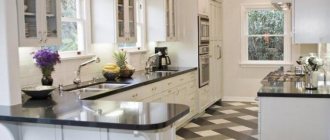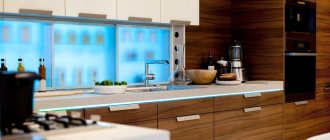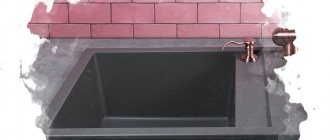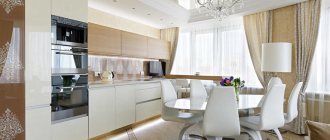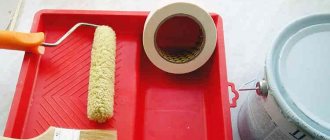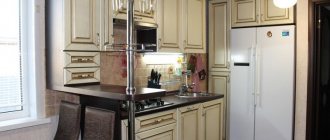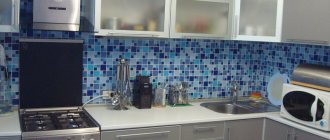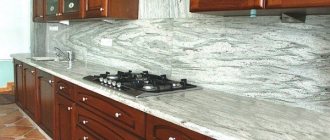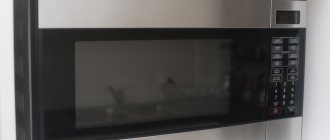Finishing laminate flooring is a popular solution in both modern and classic interiors. But many are afraid to use this coating in the kitchen. What if you want to add a beautiful texture to the interior without losing practicality? What should a laminate flooring be like for a kitchen: how to choose a coating design and protect the kitchen floor from moisture, reviews, price review and photos in the interior.
Is it possible to install laminate flooring in the kitchen?
Yes, if you choose the right type and class of coating, prepare the base well and protect the joints from moisture.
The best floor is moisture-resistant class 33, 8-12 mm thick, with a durable top protective layer, matte, slightly embossed, non-slip surface. After installation, the joints of the panels must be treated with a special water-repellent compound.
The lamella consists of four layers. The main one is a moisture-resistant HDF or fiberboard board. Pattern: Egger
Waterproof and moisture resistant laminate
Not all laminate flooring options used for kitchens are equally good and durable in everyday use. Traditionally, three categories of laminate are used for residential premises:
- An ordinary laminate capable of absorbing water and condensate at least 8 and up to 16% of the volume. To make the lamellas waterproof and used for kitchen flooring, the material is impregnated and glued to a moisture-resistant base using polyurethane and epoxy adhesive compositions;
- The moisture-resistant type of laminate coating absorbs 2-8% of water, the outer coating made of polymer film allows you to protect the kitchen floor from direct contact and seepage through the surface for a short time;
- The waterproof version of the laminate can absorb no more than 2% moisture, even when flooded or immersed in water. For the kitchen, this is the most acceptable type of laminate flooring.
The first two types of laminate are made from cellulose or wood fibers. Ordinary material is simply pressed under high pressure, much like fiberboard, or with the addition of active lignin solvents, as in the production of OSB panels. In any case, the result is an ordinary laminated material for the kitchen with good properties, good heat and sound insulation.
What to look for when choosing
1. Wear resistance class. The higher it is, the greater the load the coating can withstand. Laminate of at least 32, and preferably 33, is suitable for the kitchen, corridor and hallway. Without force majeure, it will last at least 15 years without losing its appearance. 34 class is even stronger, but more expensive. In most cases, there is no need to overpay for it.
2. Level of moisture resistance. Make sure that the laminate you are considering for your kitchen has moisture protection. Look in the description for markings with drops of water, a tap, the words water resistance, waterproof, aqua block, aqua protect, etc.
3. Type of locking connection. Glueless floor coverings have two of them: Click (prefabricated system) and Lock (snap lock). Click is considered more reliable and convenient: the floor will last longer, it is easier to install (even a beginner can handle it), and the base can have a difference of up to 3 mm per linear meter. Coverings with a Lock system are cheaper, but less reliable, more difficult to install (it’s better to hire a professional) and require a perfectly level base.
4. Manufacturer and warranties. Do not buy cheap laminate from unknown manufacturers on the construction market. If your budget is limited, take a look at inexpensive coatings from well-known brands or semi-commercial linoleum with a board pattern and wood texture.
5. Thickness. The thicker the laminated parquet, the stronger, more durable and more expensive it is. For the kitchen, hallway and corridor, choose a coating no thinner than 9 mm.
6. Presence of a chamfer. It is believed that laminate without chamfer is better in the kitchen (dirt and moisture do not linger in the recesses). To make the floor look more realistic, manufacturers came up with an optical chamfer. The panels along the edges are made a little darker in color, visually highlighting the contours of each board.
7. Formaldehyde emission class. Material marked E0 or E1 is considered safe for health.
8. Sound absorption level. Some types of expensive laminate have a sound-absorbing layer 1-2 mm thick (Sound Protect, etc.). But most coatings do not have it, and the substrate will have to be purchased separately.
9. Anti-slip surface. For the kitchen, choose a rough, textured laminate: it’s easy to slip on a smooth one and get injured.
Why is white laminate in the house beautiful and practical?
The choice of laminate of one color or another, as a rule, depends on the preferences of the customer. Many homeowners doubt how practical it is to make a light-colored floor? After all, it will get dirty faster, especially if people often wear the same shoes in the house as in the garden.
Actually this is not true. Yes, dirt and dust will definitely be more visible on a white laminate than, for example, on a gray or brown one, but the dirt itself does not get into the structure of the material (such as a parquet or floorboard) and this problem is easily solved with an ordinary, slightly damp cloth.
High-quality laminate boards are very difficult to damage. Even if you consciously try to scratch them, it will take you at least a hundred, or even a thousand, cycles. It should be noted that today there is no more comfortable, wear-resistant, durable and practical material at this price. In fact, you get wood flooring that is pleasing to both the eyes and the feet.
Of course, a lot depends on the quality of the laminate and its manufacturer. So, for the hallway you should choose a moisture-resistant laminate with increased wear resistance (class 33 and higher), since this area is most often used. In addition, laminate flooring in the kitchen also requires moisture resistance and specific decorative aspects.
We have already written about how to choose laminate, in particular waterproof, on our Blog. Let's now get back to the heart of the matter: Why is white flooring so popular among homeowners?
Pros and cons of laminate flooring in the kitchen
Advantages
- A high-quality floor is not afraid of impacts, scratches, cracks, temperature changes and does not fade in the sun. It is easy to clean, abrasion resistant and stain resistant.
- Laminate panels are warmer than ceramic tiles or porcelain stoneware - they are more pleasant to walk on barefoot. Some types of this coating allow you to create a heated floor in the kitchen.
- Unlike linoleum, there are no dents left on it from the legs of the refrigerator and kitchen furniture.
- It is valued for its similarity to natural wood flooring and its variety of designs. It attracts thrifty owners with its affordable price, and practical ones with ease of installation.
Flaws
It may swell and swell. If a hot water pipe bursts while you're away, there's a high chance that the kitchen floor will have to be replaced.
Solution. Treat the seams between the boards with a special sealant (for example, Hydrokit, Click guard, etc.). This will not save you from a flood, but under normal conditions the risk of damaging the coating will be less.
Laminate can be moisture-resistant or water-resistant. These are two different types of coverage. They are made from different materials and behave differently when in contact with water.
The surface of the moisture-resistant laminate has a protective layer and does not allow water to pass through, and the locking joints are impregnated with wax-containing compounds. But if you spill a lot of water, it will seep into the joints between the panels. The plates may become warped and the seams may swell. If the kitchen floor is deformed, it will not be possible to return it to its original appearance.
- Tip: If you spill liquid on laminate floors, it is best to wipe it up within 15-20 minutes.
Waterproof laminate is insured against such troubles. Its base is made of plastic, not fiberboard. But the choice of design for waterproof coatings is limited, and their price is higher.
“Clicking” and loud knocking. Laminate floors are often criticized for their noise - the characteristic ringing sound from footsteps, pet claws and fallen objects. If there is no backing between the coating and the base, the air gap between them creates a drum effect. If the floor is also poorly leveled, the slats begin to creak over time.
Solution. A sound-absorbing substrate made of cork or expanded polystyrene helps to avoid problems. It absorbs steps, smoothes out uneven ground surfaces and reduces impact noise by approximately half.
Scratches and chips. Laminate is not as capricious as solid or parquet boards. But serious damage may also appear on its surface, as in the photo below:
An improperly hung door left a deep mark on the floor.
Solution. You can buy special wax pencils to match the color of your floor and disguise the defect.
How to choose laminate for the kitchen
When deciding which laminate to choose for the kitchen, you need to focus on the characteristics of the lamellas. First of all this:
- moisture resistance. Difficult operating conditions of the floor covering: high humidity and sometimes spilled water require the purchase of a moisture-resistant laminate. The fact that the product resists moisture is indicated by markings on the packaging in the form of a tap, a drop of water, the inscription “Aqua” or a drawn umbrella;
- wear resistance. Here you need to be especially careful. In popular literature, concepts are constantly being replaced: the strength class is attributed to the level of wear resistance. This kind of incident also occurs among professional craftsmen and experts. Therefore, you need to focus not on icon 33 or 34 (indicates the strength class), but on the combination of the letters AC and the numbers 3 or 4 or the number of people on the floor on the pictogram (see photo). For an apartment as a whole, abrasion class AC3 is sufficient, for the kitchen you need AC4 - too many people go there. And one more thing: wear resistance is not identical to the concept of hardness. This means that laminate flooring can withstand shuffling feet just fine, but suffer scratches or dents from pets' claws or falling breakable objects;
Abrasion class designations.
- strength. The criterion shows what dynamic and static load the slats can withstand during operation. That is, how much weight one panel can withstand over a long time. Let us be clear: you should not believe the numbers printed on the packaging. Reliable data is available only from products of German and Belgian companies. Although here, not everything is clear. Thus, the best models of class 32 have a higher level of strength than laminate in the class 34 segment, but with a more affordable price. One thing can be said about the products of Russian and Chinese enterprises - it’s a pig in a poke: you can buy both a good laminate and one with low strength characteristics. If we get lucky. For the kitchen, class 34 seems to be the best option - because of the refrigerator;
- surface type. The smooth surface of the laminate becomes slippery after wet cleaning. Therefore, it is better to buy textured slats. This is not only safety, but also a beautiful design, most often a wood look.
The cost of 1 m2 of laminate and its durability also play an important role. Although you don’t have to choose too much based on price: class 34 laminate with a high degree of wear resistance is correspondingly expensive (price starts from 2,500 rubles/m2).
Laminate and warm floor
Many manufacturers offer coatings under which a heated floor system can be installed. But under a number of conditions.
- Laminate flooring cannot be laid over an electric floor heating system. Due to rapid and uneven heating, the planks may become deformed and gaps will appear between them. It is better to use water or infrared film heated floors.
- Increase the floor temperature gradually. The main thing is not to allow the surface to heat up more than 27-28 degrees. You will have to install temperature sensors and a rheostat for smooth temperature control.
- During the heating season you will have to use a humidifier. To prevent the laminate from drying out, the humidity in the kitchen should be at least 50%.
Types and classes of laminate for the kitchen and prices
Since the kitchen space has its own characteristics in terms of operation, humidity and temperature conditions, the laminate here must meet certain characteristics.
- Laminate class. To cover the kitchen, use a laminate with a strength category of at least 32. It determines the density of the base - MDF board. The higher the class, the denser and stronger the base and, accordingly, the more reliable the laminate.
Abrasion class. It is labeled AC3 – AC5. Accordingly, the better the wear resistance, the longer the coating will last. But how to arrange furniture in the kitchen and what kitchen furniture is the best and most popular can be seen here.
- When choosing, focus on the moisture-resistant laminate and the strength of the paint layer. This laminate has a special impregnation that is resistant to aggressive environments and is marked with a special W symbol.
- A new material on the construction market is considered universal and 100% resistant even to flooding - vinyl laminate . It is based on polypropylene and PVC film. They offer few colors, but it will never swell. Its coating is resistant to chemicals, moisture, high temperatures, and vapors of any intensity. But you can see which panels for kitchen walls are the best and most suitable for flooring here.
Design options
Board size The most popular laminate format for the kitchen is a rectangular plank with a length of 1200-1380 mm and a width of 190-200 mm. But all major manufacturers offer collections with longer or shorter, narrower or wider elements.
Egger
With or without chamfer Wood laminate sometimes has a chamfer - beveled edges. When connecting the panels, grooves are formed - they emphasize the similarity of the panels with a solid board floor or natural piece parquet. The planks can be chamfered on only two sides (indicated by the marking 2V) or on all four sides (4V).
An example of a laminate with a double-sided chamfer in a kitchen interior
Number of stripes A “wooden” floor can have one or more stripes in a block. Examples are in the photo below:
Single-strip laminate - one pattern runs across the entire width of the board
Two-lane - the die is “divided” in half
Multi-strip laminate flooring in the kitchen combined with the living room
White floor. How to avoid mistakes?
First of all, when choosing white floors, carefully consider the color theme of the entire room decoration. As we said above, you should not make the floor lighter than the walls - in rare cases it looks good, but rather you will achieve the opposite effect.
In addition, it is also important to choose the right shade of the board. It is well known that there are “cold white” and “warm white” colors. As you might guess, a cold shade will go better with cold finishing colors: blue, blue, lilac, etc., and a warm shade will go better with brown, yellow, orange, etc.
You should not choose a cold white laminate for beige wallpaper; it is better to choose a board with a brown tint or streaks. But for gray or snow-white wallpaper, snow-white floors would be the ideal solution.
Another common issue that customers face is: what is better, matte or glossy laminate? It's a matter of taste here. Designers note that the matte finish is more wear-resistant and looks more natural than glossy laminate. Although, in some cases, gloss will be more appropriate - for example, in a high-tech style finish.
Try, fantasize, experiment. You shouldn’t be afraid of the fair sex, as our ancestors were afraid of. Today, such floors are made all over the world, because they really look very vintage, impressive and stylish.
Decors
Wood Modern wood or board laminate imitates different species: traditional oak, ash, pine, walnut, chestnut, exotic merbau, wenge, zebrawood, etc.
The accent floor will steal all the attention
Oak laminate has the most variations - natural, bleached, stained, aged, tinted, varnished or oiled...
Arizona Oak
Oil white
Balmoral Oak
Colonial
In inexpensive collections, the pattern on the dies is the same type. Expensive coating looks more natural: there are more boards with different patterns, there are transitions from light to dark, and the image is so clear that you can see the pores of the wood.
The calm colors of laminate flooring are perfect for kitchens in both classic and modern styles.
Tile, stone or concrete Laminate under tile or stone (slate, travertine, limestone, etc.) is a good choice if you like the look of tiles in the interior, but don’t want to put up with such shortcomings as an eternally icy floor and guaranteed breakable dishes.
A concrete laminate would fit perfectly into a modern loft, minimalist or hi-tech interior (available from Kronotex, Alloc, Pergo, Parador, Balterio, etc.).
Is it possible to combine tiles and laminate?
Practice shows that a combined tile and laminate floor in the kitchen is the most effective way to solve the problem of flooring in the busiest room of the apartment. In this case, the combination is always carried out according to the same scheme: the work area is tiles, the dining area is wear-resistant laminate.
This approach eliminates several problems:
- a safe sanitary area appears with a durable coating of tiles or porcelain stoneware, which is almost 2 times more wear-resistant than the best laminate;
- water leakage under the kitchen unit can be easily eliminated without consequences for the floor;
- the furniture and refrigerator sit on the tile like a glove - there is no play, like on laminate;
- There was an opportunity to lay ordinary (non-moisture resistant) laminate in another part of the kitchen, where there is no grease and water.
But such a floor covering has other design-related problems: how to choose the right laminate for the tiles in the kitchen so that the floor is a single whole and does not create the impression of an ever-drawn-out renovation.
Quantity calculation
Buy flooring with a margin of at least 5%. If the floor gets damaged, you can easily replace the damaged part.
If you plan to lay diagonally or are going to do the installation yourself, take 12-15% more material.
For a kitchen-living room of complex shape, for example, with a bay window or a large number of corners, focus on a margin of 15-17%.
Structure and materials of waterproof slats
There are two types of waterproof slats on the market:
- The matrix is made only of polymer materials;
- Composite laminate based on pressed lignin-cellulose mass impregnated with polyethylene and polyurethane compounds.
Laminate based on polymer-wood composites is considered the cheapest and most affordable in the line of waterproof lamella coatings. It tolerates watering well and even long-term, up to 5 hours, stay in water. The coating has good thermal insulation, but due to the short fiber from which the matrix is made, it is considered stiffer and more brittle. When laying slats, good leveling of the kitchen floors and special care when joining the locks are required. In terms of its characteristics, waterproof laminate is closest to decking.
The polymer version of the waterproof laminate is made on the basis of a polyvinyl chloride substrate that has undergone high pressure treatment. The intermediate layer can be made of polyethylene or polypropylene. Next is decorative PVC film or paper, the top layer is made of polyurethane or heavy-duty polyester film.
The strength of a waterproof laminate is evidenced by the fact that on its surface you can crack nuts, place hot dishes for a short time, wash with any type of detergent, and even put out cigarette butts if someone comes up with such an idea.
Laying nuances
- If you don’t want problems with the floor, follow the instructions exactly: each manufacturer of laminate flooring gives detailed recommendations for its installation.
- Laminate flooring can be laid on a concrete screed, wooden floor, ceramic tiles, or glued linoleum. The main thing is that the base is dry (humidity less than 2%) and level (the height difference is no more than 2 mm per meter for panels 6-7 mm thick and 3 mm per meter for planks thicker than 8 mm).
- The joints between the panels are less noticeable if you place the slats in the direction of the light from the window.
For a large kitchen or kitchen-living room, the best option is a combination of ceramic floor tiles in the “wet” area and laminate flooring in the rest of the space
Wooden floors pair beautifully with patchwork tiles
In what styles and rooms is white laminate used: choose an option to your liking
What styles does white welcome? This is a whole range of multi-directional interior design:
- Mediterranean;
- classic;
- Scandinavian;
- minimalism;
- high tech;
- nautical.
If brown flooring is the most common classic and neutral option, then the use of white laminate brings a fresh spirit to interior ideas.
Not only the direct choice of style plays a role, but also the direction of the room: it is important whether laminate flooring is selected for the kitchen, bedroom or living room.
Experiments with the color of coatings should be bold, but thoughtful. You need to understand what exactly in the room should be emphasized and what should be veiled.
We've already talked about how well white brings out bright colors. This option can be played in different styles. For example, for marine and Mediterranean, it would be advantageous to highlight blue or azure tones of the walls, and for high-tech, a combination with dark coffee walls and furniture would be interesting.
As for modern expressions of styles in the interior of apartments, bold decisions are welcomed: so many shades and textures go with white laminate that you can get confused in choosing. This color becomes not only the background color on the floor surface, but also shades and emphasizes the richness of any, even the most inconspicuous color.
In antique or retro interiors, you can also use white laminate coating, which looks like real bleached wood.
Here are other interesting solutions for apartment interiors:
Prices and manufacturers
Inexpensive class 33 laminate flooring in Moscow online stores can be purchased from 400-450 rubles per square meter. A moisture-resistant finish suitable for heated floors costs an average of 700-1500 rubles per square meter. European-made coatings will cost you from 1000 to 2500 rubles per meter.
Which laminate collections are suitable for the kitchen?
- Tarkett/Russia: Robinson, Estetica, Pilot, Woodstock Family, Riviera, Artisan
- Kronostar/Russia: Salzburg, Symbio, Synchro-Tec, De Facto
- Kronospan/Belarus and Russia: Titan Prestige, Forte Classic, Quick Style
- Kronotex/Germany: Amazone, Ribusto, Mammut
- Ritter/Russia: Nefertiti, Charlemagne
- Egger/Germany: Classic 8-33 or 11-33, Classic Aqua
- Quick-Step/Belgium and Russia: Classic, Arte, Impressive, Impressive Ultra
- Imperial/China: Lux, Ibiza, Lumia, Exclusive
- Classen/Germany: Extreme, Impression, Natural Prestige, Force
- Pergo/Sweden: Original Excellence, Sensation
Color and texture of waterproof laminate
The design of waterproof coatings is usually carried out in several patterns that imitate parquet or deck boards with a wide variety of surface textures.
The reason for the widespread use of “wooden” design is the arrangement of lamellas, usually a board or strip of pressed material with an aspect ratio of 1:9. For a large kitchen, 1:16 laminate is used, which allows you to create the impression of a classical type of stacked wooden floor. It can be dark stained oak or light cedar. The top sellers remain chestnut and beech colors.
Teak colors are always designed in the form of a multi-stripe pattern, while oak and conifers on the surface of a waterproof laminate are reproduced only as an imitation of a plank floor.
If you choose a waterproof laminate for the kitchen under tiles, then it is better to avoid a material with a pronounced fiber pattern on the surface; the contrast with the tiled finish is too great.
A waterproof laminate for kitchen tiles looks ideal if the coating is used in the same color as the furniture façade. Waterproof grades of laminate are somewhat darker than conventional varieties, which is explained by the presence of an additional protective layer on the surface.
The wooden pattern of the flooring does not always go well with the interior of the kitchen, so manufacturers produce a whole series of moisture-resistant plain laminate with a very small, barely visible pattern. This option is considered universal. Once you have chosen and installed a waterproof laminate floor, you can change and transform furniture sets in the kitchen without fear of dissonance in colors or textures.
How to calculate quantity
Before you begin calculating the flooring material, you need to reliably know the dimensions of an individual lamella. Therefore, first the manufacturer is selected, then the design you like. Once the exact dimensions of the kitchen, laminate flooring and the number of slats in the package are known, you can begin to calculate.
The number of boards depends on the installation method:
For direct installation, the formula is used for calculation: S (kitchen area) + 7% (of the total area, for trimmings).
When laying diagonally, the same formula is used, but 10 to 15% is added for trimming.
To calculate the number of packages, take the total area of the kitchen and divide it by the area of the lamellas in one package (this value is indicated by the manufacturer). The number resulting from division is the number of packages needed for your kitchen.
Necessary parameters for counting the number of packages
If the kitchen has a complex geometric shape, it is better to make a larger reserve (from 15 to 17%), since there will be more scraps.
Design Features
When working on the style, it is important to assess the size of the board. Typically, rectangular variations are used for the kitchen, the length of which is 1200 mm. The width should not exceed 200 mm. It is important to note that there are various variations on the market, with a wide variety of elements in width and length.
The second position is associated with the presence or absence of a chamfer. If the product is sharpened to look like wood, then the latter has special grooves. They set a non-standard effect and allow you to specify a non-standard design.
Important! When choosing, pay attention to the markings 2V and 4V, which indicate the number of sides with a chamfer.
It is important to pay attention to the design of the laminate - it is often designed to look like wood, which looks quite beautiful
As for design, wood-look variations are currently popular. That is why solutions called “oak”, “ash” and so on are presented on the market. Each option has a nuance. For example, oak has more than 50 of them. The pattern on the planks may differ. The more expensive the material, the more varied the pattern will be presented. Products imitated with natural stone deserve special consideration, as they allow for heat retention and a non-standard design.
Which laminate is ideal for the kitchen?
Of the types under consideration, only waterproof brands that are highly resistant to this negative factor are suitable for the kitchen. Similar products are also made using wood-cellulose fibers, but the crowning feature is considered to be impregnation using composite materials. Such a coating ideally retains moisture and creates ideal conditions for resisting water. It is important to understand that the joints and the reverse side do not have such protection, so manufacturers do not recommend prolonged interaction with liquid.
Over time, products wear out, which leads to a decrease in resistance levels. Film abrasion, problems with locking joints - all this requires timely repairs and high-quality maintenance.
For the kitchen you should only choose a laminate that is not afraid of water
Wood decor
Imitation wood is the most common decor for this material. Modern printing technologies provide highly realistic drawings. The leader in demand is a design that imitates noble wood species. For example: wenge, walnut, zebrawood, ash, merbau, pine. Out of competition - oak in varying degrees of staining (aged, oiled, bleached, varnished, tinted and natural).
The more expensive the material, the more attention is paid to the image and structure of the wood. Age rings, color transitions, wood pores and fibers can be clearly distinguished on the slats.
English style, baroque, eco-style, classic, country, baroque, high-tech - this is not a complete list of interior names that would suit a floor decorated with wood.
Kitchen in English style, with laminate
